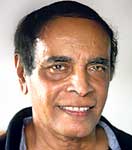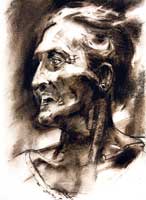
Strokes of creativity fired by childhood inspirations
A childhood passion rekindled in retirement. This is what art is to Ranjith Perera, who was inspired while in school at Trinity College, Kandy, by greats such as David Paynter whom he used to watch restore the chapel murals painstakingly and also Stanley Kirinde and Harold Hardy who came in as art teachers. Trinity itself located in a city where river, lake and mountain meet, with lush Udawattekelle right next door “fired our imagination”, says Ranjith, who during his college days won one and only one prize – the prize for art. University too did not still his itchy fingers and he was the “culprit who never got caught” who drew large figures in pencil in the hall rooms of batchmates on request, earning the fury of his uncle who was the maintenance officer. But his passion had to be reined in with a stressful job at the higher levels of Forbes and Walker. “Art was dead and buried. It remained dormant until my premature retirement,” says Ranjith seated among his paintings, last week. It was then that he began drawing and painting in earnest with encouragement from Nadine David, herself a pupil of English artist August John and also Paynter. Says a grateful Ranjith, “At the Deva Surya Centre she helped me to correct common mistakes and guided me to improve my technique.” And now art is all consuming, influenced by the great masters, he strives to draw and paint like them, gaining inspiration from Constable and Corot for landscapes and also Rembrandt, Delacroix, Titian and impressionists such as Cezanne.
The works of Michelangelo haunt him. “An art colleague once said that her neck ached for days after gazing at the Sistine chapel ceiling and I told her to spare a thought for Michelangelo’s agony,” laughs Ranjith. Nurturing a soft corner for drawing from life, Ranjith is fascinated by eyes, as depcited in his paintings. Not having models to sit around a studio, he draws anything which crosses his path – the coconut plucker, the labourer, the gardener… “subjects who have sat for me for some pocket money”. Using oil and charcoal, he believes that learning how to see is the primary issue in drawing, not what is chosen as subject matter. Preferring the texture and tones that can be obtained from charcoal, Ranjith feels that painting is a pictorial language with an extensive vocabulary.“It has been hard work but invigorating and most enjoyable,” adds Ranjith as he prepares to display his paintings and drawing. |
|| Front
Page | News | Editorial | Columns | Sports | Plus | Financial
Times | International | Mirror | TV
Times | Funday
Times || |
| |
Reproduction of articles permitted when used without any alterations to contents and the source. |
© Copyright
2007 | Wijeya
Newspapers Ltd.Colombo. Sri Lanka. All Rights Reserved. |

